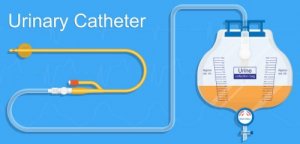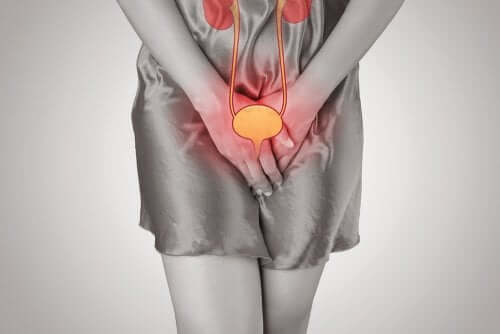Treatment of Postpartum Urinary Retention

Postpartum urinary retention is the inability to pass urine spontaneously in the 6 to 12 hours after vaginal delivery. The most common cause of postpartum urinary retention is the lack of pelvic floor relaxation after vaginal delivery. It may worsen due to a particularly painful episiotomy or assisted vaginal delivery.
For this reason, it’s very important to maintain good analgesia and take appropriate measures. This way, the pelvic floor will relax and the patient will be able to urinate.
Types of postpartum urinary retention

Postpartum urinary retention can be classified as:
- Symptomatic. Identified by the ability to expel urine accompanied by discomfort.
- Covert or asymptomatic. In this case, doctors diagnose postpartum urinary retention due to a high post-void residual volume. The volume will be equal to, or greater than, 150 ml, after spontaneous urination on the first day postpartum.
Risk factors for postpartum urinary retention
We’ll now share the risk factors that favor the manifestation of this condition. The fact that the patient suffers from any of these conditions doesn’t mean she’ll suffer from postpartum urinary retention, simply that’s she’s more likely to.
- Prolonged first and second stages of labor
- Assisted vaginal delivery
- Epidural anesthesia
- Being a first-time mother
Moreover, experts consider episiotomy and birth weight risk factors for asymptomatic urinary retention. The early detection of risk factors is very important because it allows doctors to take preventive measures to reduce the adverse effects of childbirth. It also helps them decide on appropriate treatments to regain normal bladder function.
Discover: Five Habits to Treat Urinary Incontinence
Diagnosis
In most cases, the diagnosis of postpartum urinary retention is only symptomatic, when the patient is unable to pass urine spontaneously after 6 to 12 hours postpartum.
Management of patients with postpartum urinary retention

Patients who had a normal vaginal delivery or an assisted one should urinate in the first 12 hours. In the case of patients who undergo Caesarean sections, they should urinate in the first few hours after the removal of the indwelling catheter. In other words, about 12 hours after the surgery.
If this doesn’t occur in the set periods of time, the doctors must optimize treatment with painkillers and anti-inflammatory drugs. Also, the patient must undergo intermittent catheterization. As a result, doctors can check and evaluate the patient’s diuresis volume to adjust her water intake.
If there’s no spontaneous urination in the next 3-4 hours, the patient must undergo a secondary intermittent catheterization with a disposable catheter. And if the patient still doesn’t urinate voluntarily after this second intervention, she’ll need to get a third one. However, doctors use a Foley catheter in this third intervention, which the patient will need to use for a week.
The patient has to pinch the catheter closed and open it whenever she feels the need to urinate. However, she may not feel this need, which is why it’s important for her to open the catheter every three hours or so to empty her bladder. The patient will be discharged with this Foley catheter.
Read on to learn more: Can You Treat Urinary Tract Infections Quickly And Naturally?
Pharmacological treatment
Doctors prescribe drugs in order to prevent complications in patients with indwelling urinary catheters. Some of them are:
- Fosfomycin 3g granules. The patient should take this drug every 72 hours while she’s using the catheter.
- Also, anti-inflammatory drugs to reduce local inflammation.
Conclusion
At the time of delivery, it’s essential to administer and maintain good analgesia and take appropriate measures to prevent postpartum urinary retention or other complications.
There are effective means to reverse this inability to pass urine spontaneously after vaginal delivery based on catheters. Consult your doctor about the risks of this childbirth complication and the different available options to reverse it.
All cited sources were thoroughly reviewed by our team to ensure their quality, reliability, currency, and validity. The bibliography of this article was considered reliable and of academic or scientific accuracy.
- Arcay-Ferreiro, E., Ferro-Castaño, A. M., Fernández-González, B., García-Rodríguez, B., Gonález-Gómez, J. M., Rodriguez-Del Amo, M. D., & Viaño-López, C. (2012). Sondaje vesical. Protocolo de enfermería. Asociación Española de Enfermería En Urología.
- Kanashiro, A., Nervo, N., Salas, D., wong, A., Capell, M., Younes, S., & Villavicencio, H. (2013). Retención de orina en el embarazo y el postparto TT – Retention of urine in pregnancy and postpartum. Actas Fund. Puigvert.
- Barakat, Ruben; Bueno, Clara; Díaz de Durana, Alfonso; Coterón, Javier; Montejo, R. (2013). Efecto de un programa de ejercicio físico en la recuperación post-parto. Estudio piloto. Archivos de Medicina Del Deporte.
This text is provided for informational purposes only and does not replace consultation with a professional. If in doubt, consult your specialist.








